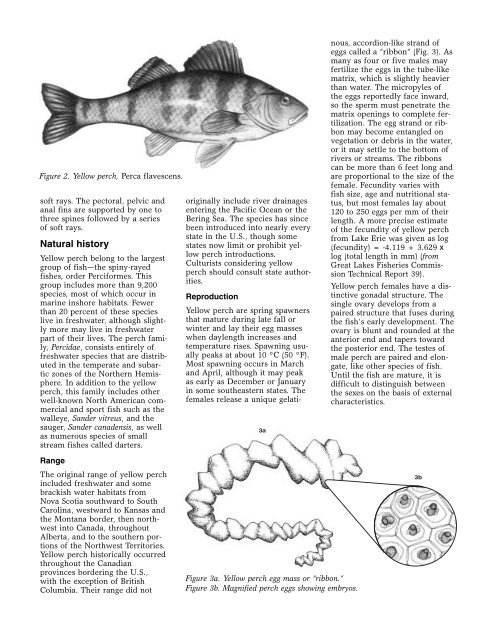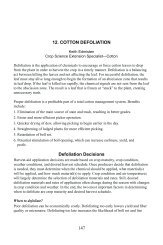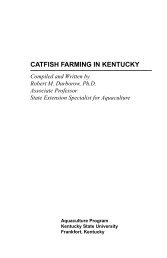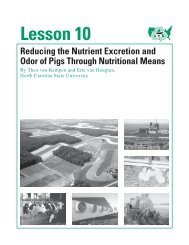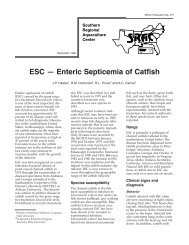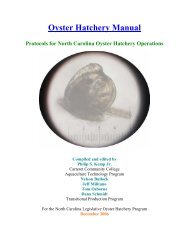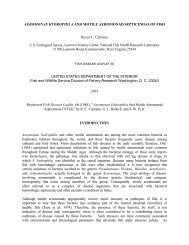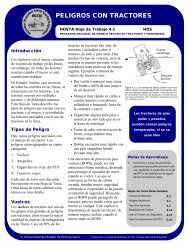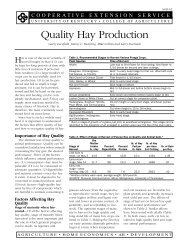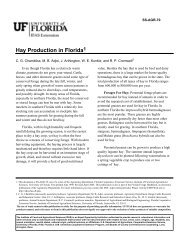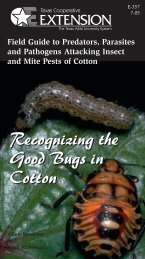Species Profile: Yellow Perch, Perca flavescens - SRAC Fact Sheets
Species Profile: Yellow Perch, Perca flavescens - SRAC Fact Sheets
Species Profile: Yellow Perch, Perca flavescens - SRAC Fact Sheets
Create successful ePaper yourself
Turn your PDF publications into a flip-book with our unique Google optimized e-Paper software.
Figure 2. <strong>Yellow</strong> perch, <strong>Perca</strong> <strong>flavescens</strong>.<br />
soft rays. The pectoral, pelvic and<br />
anal fins are supported by one to<br />
three spines followed by a series<br />
of soft rays.<br />
Natural history<br />
<strong>Yellow</strong> perch belong to the largest<br />
group of fish—the spiny-rayed<br />
fishes, order Perciformes. This<br />
group includes more than 9,200<br />
species, most of which occur in<br />
marine inshore habitats. Fewer<br />
than 20 percent of these species<br />
live in freshwater, although slightly<br />
more may live in freshwater<br />
part of their lives. The perch family,<br />
Percidae, consists entirely of<br />
freshwater species that are distributed<br />
in the temperate and subartic<br />
zones of the Northern Hemisphere.<br />
In addition to the yellow<br />
perch, this family includes other<br />
well-known North American commercial<br />
and sport fish such as the<br />
walleye, Sander vitreus, and the<br />
sauger, Sander canadensis, as well<br />
as numerous species of small<br />
stream fishes called darters.<br />
originally include river drainages<br />
entering the Pacific Ocean or the<br />
Bering Sea. The species has since<br />
been introduced into nearly every<br />
state in the U.S., though some<br />
states now limit or prohibit yellow<br />
perch introductions.<br />
Culturists considering yellow<br />
perch should consult state authorities.<br />
3a<br />
Reproduction<br />
<strong>Yellow</strong> perch are spring spawners<br />
that mature during late fall or<br />
winter and lay their egg masses<br />
when daylength increases and<br />
temperature rises. Spawning usually<br />
peaks at about 10 °C (50 °F).<br />
Most spawning occurs in March<br />
and April, although it may peak<br />
as early as December or January<br />
in some southeastern states. The<br />
females release a unique gelatinous,<br />
accordion-like strand of<br />
eggs called a “ribbon” (Fig. 3). As<br />
many as four or five males may<br />
fertilize the eggs in the tube-like<br />
matrix, which is slightly heavier<br />
than water. The micropyles of<br />
the eggs reportedly face inward,<br />
so the sperm must penetrate the<br />
matrix openings to complete fertilization.<br />
The egg strand or ribbon<br />
may become entangled on<br />
vegetation or debris in the water,<br />
or it may settle to the bottom of<br />
rivers or streams. The ribbons<br />
can be more than 6 feet long and<br />
are proportional to the size of the<br />
female. Fecundity varies with<br />
fish size, age and nutritional status,<br />
but most females lay about<br />
120 to 250 eggs per mm of their<br />
length. A more precise estimate<br />
of the fecundity of yellow perch<br />
from Lake Erie was given as log<br />
(fecundity) = -4.119 + 3.629 x<br />
log (total length in mm) (from<br />
Great Lakes Fisheries Commission<br />
Technical Report 39).<br />
<strong>Yellow</strong> perch females have a distinctive<br />
gonadal structure. The<br />
single ovary develops from a<br />
paired structure that fuses during<br />
the fish’s early development. The<br />
ovary is blunt and rounded at the<br />
anterior end and tapers toward<br />
the posterior end. The testes of<br />
male perch are paired and elongate,<br />
like other species of fish.<br />
Until the fish are mature, it is<br />
difficult to distinguish between<br />
the sexes on the basis of external<br />
characteristics.<br />
Range<br />
The original range of yellow perch<br />
included freshwater and some<br />
brackish water habitats from<br />
Nova Scotia southward to South<br />
Carolina, westward to Kansas and<br />
the Montana border, then northwest<br />
into Canada, throughout<br />
Alberta, and to the southern portions<br />
of the Northwest Territories.<br />
<strong>Yellow</strong> perch historically occurred<br />
throughout the Canadian<br />
provinces bordering the U.S.,<br />
with the exception of British<br />
Columbia. Their range did not<br />
Figure 3a. <strong>Yellow</strong> perch egg mass or “ribbon.”<br />
Figure 3b. Magnified perch eggs showing embryos.<br />
3b


